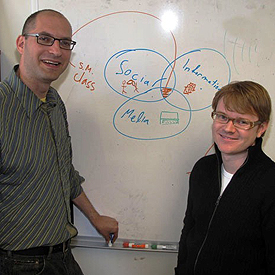
Whether announcing a new job or just what they ate for breakfast, people across the globe have taken to sharing their lives and connecting with other people many times a day through various forms of social media.
The information people choose to share – whether it’s on Facebook, MySpace, Flickr, Twitter, or a host of other social media sites – and the technology they use are the subject of a new class at Rutgers this fall.
“Understanding and Building Social Media: An Interdisciplinary Approach” is the first Rutgers course to focus on social media. The goal of the class, which was open to graduate students, is to use social science, information science, and computer science to study the design and use of social media.
“We’re interested in core ideas: why people use social media and how they make sense of information,” said Jeff Boase, an assistant professor of communication, who is co-teaching the class with Mor Naaman, an assistant professor of library and information science.
The new course is being offered by the School of Communication and Information and is cross listed in the Department of Computer Science.
Boase and Naaman are both in their second years at Rutgers and come at the topic from different perspectives. Boase, who studies social networks, said he’s interested in evaluating how social media impacts people’s relationships and interactions. Naaman, a former research scientist at Yahoo!, is more interested in how to improve social media services as useful sources of information.
Among other things, the class will look at what motivates people to communicate using social media and the social science theories that help explain it. Students will also collect data regarding how people use the technology and use those results to develop other applications.
The course is designed so that students from diverse academic backgrounds, including computer science and the social sciences, will collaborate in teams.
Plans call for students to develop their own social media applications, such as a Facebook application, by the end of the semester.
“They’ll be exposed to different ways of thinking about the area,” Naaman said. “Transformative value comes from interdisciplinary efforts.”